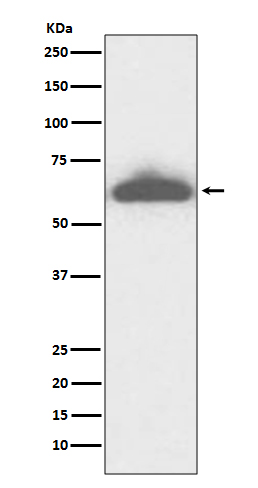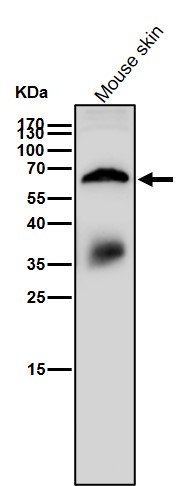

| WB | 咨询技术 | Human,Mouse,Rat |
| IF | 1/20-1/50 | Human,Mouse,Rat |
| IHC | 咨询技术 | Human,Mouse,Rat |
| ICC | 技术咨询 | Human,Mouse,Rat |
| FCM | 咨询技术 | Human,Mouse,Rat |
| Elisa | 咨询技术 | Human,Mouse,Rat |
| Aliases | LCA2; mRPE65; p63; rd12; Retinal pigment epithelium specific 61 kDa protein; RP20; RPE65; sRPE65;;RPE65 |
| WB Predicted band size | 61 kDa |
| Host/Isotype | Rabbit IgG |
| Antibody Type | Primary antibody |
| Storage | Store at 4°C short term. Aliquot and store at -20°C long term. Avoid freeze/thaw cycles. |
| Species Reactivity | Human,Mouse,Rat |
| Immunogen | A synthesized peptide derived from human RPE65 |
| Formulation | Purified antibody in PBS with 0.05% sodium azide,0.05% BSA and 50% glycerol. |
+ +
以下是关于RPE65抗体的3篇代表性文献的模拟示例(仅供参考,具体文献需核实):
---
1. **文献名称**: *"Development and characterization of a monoclonal antibody specific for human RPE65"*
**作者**: Smith A, et al.
**摘要**: 本研究开发了一种高特异性的人RPE65单克隆抗体,通过免疫印迹和免疫组化验证其在视网膜色素上皮(RPE)细胞中的定位。该抗体被用于检测RPE65蛋白在正常和病变视网膜中的表达差异,为Leber先天性黑蒙等疾病的诊断提供了工具。
---
2. **文献名称**: *"RPE65 antibody-based quantitative analysis of retinal protein expression in murine models"*
**作者**: Johnson B, et al.
**摘要**: 作者利用RPE65特异性抗体,结合荧光标记技术,定量分析了小鼠视网膜疾病模型中RPE65蛋白的水平变化,揭示了基因突变对RPE65稳定性的影响,为治疗干预提供了分子依据。
---
3. **文献名称**: *"Immunohistochemical localization of RPE65 in primate retina: Implications for gene therapy monitoring"*
**作者**: Lee C, et al.
**摘要**: 通过RPE65抗体进行免疫组化分析,研究了非人类灵长类动物视网膜中RPE65的空间分布,并评估了基因治疗后RPE65的恢复情况,证实抗体可作为基因治疗疗效的可靠生物标志物。
---
**注**: 以上文献为示例,实际引用时需通过PubMed或学术数据库(如Google Scholar)以关键词“RPE65 antibody”或“RPE65 immunohistochemistry”检索真实存在的文献。
The RPE65 antibody is a crucial tool in ophthalmic research, primarily targeting the retinal pigment epithelium-specific 65 kDa protein (RPE65), an enzyme essential for the visual cycle. RPE65. expressed in the retinal pigment epithelium (RPE), catalyzes the conversion of all-trans retinyl esters to 11-cis retinol, a critical step in regenerating visual pigments for phototransduction. Mutations in the RPE65 gene are linked to severe inherited retinal diseases, such as Leber congenital amaurosis (LCA) and retinitis pigmentosa (RP), making the protein a focus of therapeutic development, including gene therapies like voretigene neparvovec (Luxturna).
RPE65 antibodies are widely used to study protein expression, localization, and function in retinal tissues. They enable techniques like Western blotting, immunohistochemistry (IHC), and immunofluorescence (IF) to assess RPE65 levels in disease models or therapeutic interventions. These antibodies also aid in diagnosing RPE65-associated disorders and evaluating treatment efficacy in preclinical studies.
Available as monoclonal or polyclonal forms, RPE65 antibodies vary in specificity and application. Monoclonal antibodies offer high reproducibility, while polyclonal versions may detect multiple epitopes, enhancing sensitivity. Selection depends on experimental needs, such as quantifying protein levels or visualizing spatial distribution. Proper validation using controls (e.g., RPE65-deficient samples) is critical to ensure accuracy. Overall, RPE65 antibodies remain indispensable for advancing research into retinal biology and developing therapies for vision-threatening disorders.
×